Letters – Our readers write: Autumn 2011
Letters published in the AUTUMN 2011 edition of In The Hills magazine.
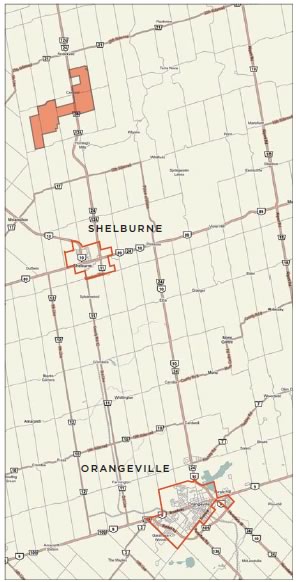
The correct location is shown above. We also failed to credit the map to CAUSE, which supplied the correct original.
Mega quarry woes
CORRECTION: QUARRY LOCATION
Our profound apologies and thanks to John Church and other readers who pointed out the egregious error in the map in our summer issue showing the location of the proposed Melancthon quarry. In a Photoshop slip, we moved the quarry location one line east. The correct location is shown above. We also failed to credit the map to CAUSE, which supplied the correct original.
____________________
Because of Tim Shuff’s article on the mega quarry (Birth of a Protest, summer 2011), I spent a wonderful morning photographing the beauty of that area. I wanted to try and photograph my impressions of the land, how vast this area of proposed devastation was going to be, and what it was going to swallow. On arrival, I noted the beauty of the country (very rarely are we blessed with such long views from such high vantage points) and the sheer size of the area being farmed going off into the distance concession by concession. It impressed upon me the obvious care and respect the farmers are taking and the varieties and healthiness of the crops.
I drove all the roads on the map trying to come up with a way of conveying what I was seeing and feeling in this beautiful piece of country.
Did my photographs convey what I set out to capture? I tried, but I don’t think you can capture all of such a vast piece of land.
The quarry is something I hope will never happen, but those in the fight to stop it will need help. I urge each and every one of the readers to go as I did and stand at the corner of 20 Sideroad and Melancthon Town Line, look to all points of the compass, and think what it would be like if most of everything you can now see was no longer there.
John Church, Caledon
Excellent article! Tim Shuff eloquently and effectively captures the spirit and momentum of the “No Mega Quarry” movement. My only comment is that the fact that Highlands claims that the quarry will have to be “dewatered” to the tune of 600,000,000 litres of water per day comes late in the article, almost as an afterthought. This is the single biggest issue with this proposed extraction, though of course it may not be for the people living on fertile farmland that could one day be a deep, rocky chasm.
Carl Michener, Alliston
Let’s keep fighting. We need good Canadian-grown food and pure water for our future generations. Don’t let a foreign company rob us of our precious natural resources.
Wayne Patterson, Niagara
Great article, but I am surprised and disappointed that there is no mention of The Coalition of Concerned Citizens and their recent battle and defeat of local aggregate company James Dick in its Rockfort Quarry application. I am equally disappointed that the CCC doesn’t even make mention of the Melancthon quarry on their website. Environmental issues don’t stop at the imaginary borders we’ve drawn up on a map.
Matthew, Caledon, web comment
The great and amazing thing about the power of the people is watching each person do something. With today’s online technology you can literally watch the ripples of action extend further and further each day. The proposed Melancthon quarry is so outrageous, so offensive to Canadian sensibility that it is not difficult to get people to act – from adding friends to the “Stop the Quarry!” group in Facebook, to meeting with their MPP. Of course, this fight will not be easy – a quick review of the Flamborough fight has shown me that, but I have faith. Site 41 was very inspiring. And the Rockfort quarry. We just have to be as tenacious as those who are going after profit. Our profit will be in landscape, food and clean water today, tomorrow and for the next generation.
Donna Baylis, Creemore
Thank you for such a great article. I cannot imagine the environmental disaster if this pit is allowed to go in. We have farmed up here for 24 years. When we were looking to purchase farms, this area had the perfect soil and climate suited to our crops. As Bill French said in the article “there is nowhere else to go” and we always wanted to remain here and call this our “home.” Thank you for keeping the word in everyone’s face and keeping it on their minds. It took me a while to “get it” and I am going to live beside this mega quarry if it is allowed to go in. I understand people’s apathy saying “it is a done deal already” but, People, it is not a done deal yet!! Keep writing great articles, spread the word and send videos. I know the video of the blasting being done was the one that made me have my “aha” moment. It opened by eyes.
Diane French, Shelburne
What a wonderful article, Tim Shuff. It’s sad that the citizens of Ontario need to fight for their water and their land, but I have to admit, this potential environmental disaster has brought out qualities in my neighbours that make me proud to live in their midst. The fight is far from over, but at least now we know, thanks to articles such as this one, that we will be heard, and that we will not stand by when unabashed greed attempts to destroy our resources.
Gail, Shelburne, web comment
Thanks, Tim Shuff, for an excellent article about the fierce battle to stop the Highland Companies from destroying vital agricultural land and threatening our fresh water resources in perpetuity. Country and city are uniting against this reckless proposal as the Ontario election draws closer. I think we should be asking every candidate who wants our vote to state their position on the mega quarry. One of the many questions we could ask is: Will your party promise that there will be no quarries of any size on prime agricultural land? The parties’ answers should determine the outcome on October 6th.
Tess Mansfield, Mulmur
Thanks for this powerfully moving revelation of the issue, packed with people connections. The in-depth coverage and accompanying photos were instrumental for visualizing the impacts, illustrating the interrelated reality that makes this a crucial concern, and helping to reveal the monumental task of the defence demanded and undertaken. This seems a poignant reminder of the struggle that went into saving Clayoquot Sound, but I feel exposure through excellent articles like this will greatly assist resolution without need for those extreme actions. People power + press = success! With such a great geographical distance separating me from my neighbours this has been a heartwarming introduction to the many passionate people protecting my backyard. Thank you to all involved!
Jayne Wilson, Columbia-Shuswap, BC
We now have another mega project to worry about. Just received notice of a mega wind project, about six times the size of the mega quarry and overlapping the same area. This 100 MW wind producer will dominate the landscape, kill hundreds of birds yearly, further impact the local environment and – perhaps – create even more dust and pollution from the construction and the ninety-foot blades turning to churn up nice limestone dust from the quarry. Again, local government and residents have no real say, although there are four public meetings planned. Details are at dufferinwindpower.com a protest or civilian voice site designed to inform on this issue. Just one more thing to worry about! Let’s stop the quarry and stop the Mega Dufferin Wind Power project too. It’s biggest risk will, again, be to farmers.
Derek Armstrong, Shelburne
I read with intrigue the article about the proposed Melancthon quarry in the summer issue and you had my interest up to the point where you listed some statistics (complete with sources) about the development. I stopped reading there, since the way you have chosen to cite your sources is completely laughable and basically useless to someone interested in checking up on those sources.
Any Grade 9 high school student knows how to correctly cite references when they are completing a research project, so it’s a pity that the author of this article has either forgotten that skill or chosen to ignore the accepted format(s) for citing references. If you want people reading your articles (and by extension, your publication) to take you seriously, then you need to make sure that you start referencing your sources correctly so that your readership can be properly informed. Putting down only acronyms or something like “In The Hills research” and then expecting your readers to do the legwork in order to verify your sources does nothing but frustrate them, turn them off and diminish the quality of the reporting/writing in your publication…
I have a very high regard for the gifted (grade nine) students that I teach and most of them can write (and cite sources) at a higher level than what I have read in your article. I will be using your article to show all of my students (from 9-12) how not to cite references for their work.
Nick Cox, e-mail
Now that’s what I call statistics! Bravo!
Carl Michener, Alliston
This is great journalism, very well referenced. Thank you Tim Shuff!
Johnny Dib, Toronto
Editor’s Note:
For more reader response on Tim Shuff’s article, Birth of a Protest, see the comments section at the end of the article.
Gratitude to volunteer firefighters
Thank you for your article on the Grand Valley Fire Department (A Day in the Life of a Volunteer Firefighter, summer 2011). In the early morning of February 22, 1988, our house in Waldemar was on fire. First on the scene was the Grand Valley F. D. Alas, the fire got the better of them, even with support from the Orangeville F.D. and Shelburne F.D., so the house had to be destroyed.
Thankfully, we did manage to save some personal things because of their efforts. Even our 17-year-old cat survived when a firefighter carried his limp body to the waiting ambulance and put him under the oxygen mask. He lived for a year after that experience. Some of these firefighters were our friends and neighbours who risked their lives to save our home. I will always have a soft spot in my heart for them.
Sally Mappin, Erin
My nephew Neil also serves in Grand Valley Fire Dept. and makes us proud every day, as do all our firefighters all over our country and around the world. Every Christmas eve for years when my health allowed, I took a cookie tray, in my father’s name (he was also a firefighter), up to our fire hall here. My way of giving thanks.
Cindy Gasperski, Jackson’s Point
Heron identification
Last Sunday morning, my wife Donna and I were in our usual place on a sunny weekend morning. From our back deck overlooking the pond we noticed a larger bird in flight coming to perch high in a tree adjacent to our house.
After referencing our bird books, we could not identify the bird with 100 per cent confidence. I then went through our collection of back issues of In The Hills and settled in with the article in the spring 2010 issue by Don Scallen featuring herons (Herons & Co.)
Thanks to this article we were able to identify, without doubt, the American bittern sitting in our tree. Not only is your wonderful magazine enjoyable reading, but it can also be used as a reference document.
Donna & Dave Frantz, Caledon
Heron Corrections
I’m sure I’m neither the first nor will I be the last to mention that the picture of the heron on page 12 of the Autumn issue is, I believe, a green heron not an American bittern. To start with, it is unusual, although not unheard of, for bitterns to roost in trees. Second, the markings and colours match a green heron.
Compare the two pictures below. Notice the distinctive cinnamon colour on the neck of the green heron (which is clearly visible in the picture in the magazine) and the white stripe running from the throat.
This has been a good year from green herons and I have been lucky to spot many in several different locations within Caledon. Bitterns are more elusive and I have only seen one or two this year.
Gordon Morton from Palgrave, ON
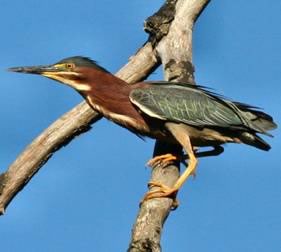
Green Heron
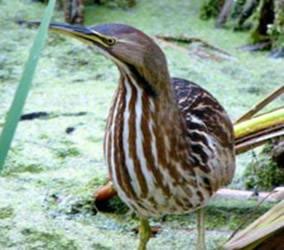
American Bittern
In his letter to the editor (Volume 18 No 3 2011 p12), Dave Frantz stated “Thanks to this article [Spring 2010] we were able to identify, without doubt, the American Bittern sitting in our tree.” Unfortunately, the bird he photographed was a Green Heron. The rust and white striped breast, yellow eye and yellow under the lower mandible are far more distinctive characteristics for this bird than the straw and brown striped breast of an American Bittern. I’ll bet the past article was a good one regardless.
David Bruce Johnson, Creemore
Shakespeare for all
The prefix “South Mulmur,” and the absence of an indication of how the Shakespeare Study Group might be contacted, may have left readers of Cecily Ross’s gratifying article (Reading Shakespeare in Mulmur, summer 2011) with the impression that we are limited to residents of south Mulmur and closed to newcomers. In fact, members of the group come from Palgrave, Orangeville, Creemore, Meaford and Mono, as well as Mulmur. We can be reached at [email protected].
Brian Bixley, Mulmu
Online In The Hills
We welcome your comments! For more commentary from our readers, or to add your own thoughts on any of the stories, please add a comment at the bottom of any article. You can also send your letters by e-mail to [email protected] or use our handy submission form. Please include your name, address and contact information. In the Hills reserves the right to edit letters for publication.
r


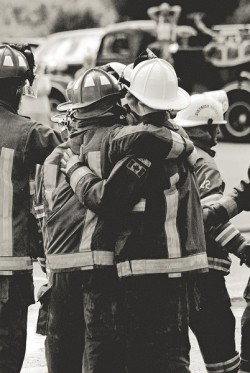
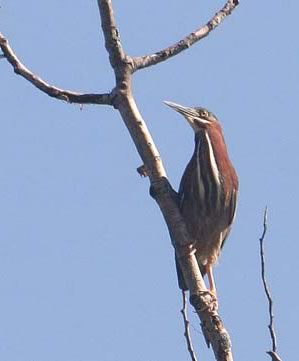






One of your readers has supplied a bird photo that they have incorrectly identified as an American bittern. Actually, the bird pictured is a green heron. The wide rusty-coloured and narrow white vertical stripes along the neck are diagnostic for green heron. A bittern has light and dark brown stripes of roughly equal width.
Pat Hodgson from Toronto on Oct 29, 2011 at 11:46 am |
I’m sure I’m neither the first nor will I be the last to mention that the picture of the heron on page 12 of the Autumn issue is, I believe, a green heron not an American bittern. To start with, it is unusual, although not unheard of, for bitterns to roost in trees. Second, the markings and colours match a green heron.
Compare the two pictures below. Notice the distinctive cinnamon colour on the neck of the green heron (which is clearly visible in the picture in the magazine) and the white stripe running from the throat.
This has been a good year from green herons and I have been lucky to spot many in several different locations within Caledon. Bitterns are more elusive and I have only seen one or two this year.
Gordon Morton from Palgrave, ON on Oct 17, 2011 at 9:57 am |